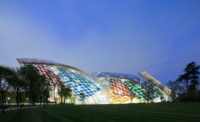Tokyo
Despite Japan's energy belt-tightening, triggered by the Great Eastern Japan Earthquake of 2011, dazzling lighting effects still bedeck most luxury boutiques in Tokyo's Ginza shopping district. But a new Louis Vuitton facade designed by Jun Aoki trumps them all, with understated, energy-conscious elegance. The eight-story aluminum skin wrapping a corner of the existing Matsuya Department Store building is illuminated by a subtle light grid, realized not by using more electricity but by using less.
In addition to this self-imposed limit on light usage, Aoki had to cope with stringent construction restrictions. He could not exceed a depth of 18 centimeters (about 7 inches) or a weight of 40 kilograms per square meter (8.2 pounds per square foot). The architect also wanted to distinguish the unique identity of the boutique, which occupies a berth on the department store's bottom three floors. In response, Aoki devised a stylized checkered pattern in lightweight aluminum, based on the Louis Vuitton signature damier, or check pattern. Extending up the department store's full height, the punctuated opalescent surface appears to be the facade of a separate building.
By day, the corner shop is distinct from its surroundings, with a solid presence among the attention-grabbing storefronts nearby. But the potency of Aoki's design is at its most compelling when the sun goes down, and the gradated layout of his textural wrapping transforms the building into a light box that enlivens the corner with a uniform intensity. To achieve this effect, the architect took advantage of his overall motif and punched the metal wrapping with circular indentations, concealing each one with a slightly curved, square overlay. Connecting the two layers at each juncture, metal cylinders ringed with LEDs are the facade's only light source. Selected for their overall efficiency, the LEDs emit a glare-free glow that leaks delicately from behind the overlays, illuminating and exaggerating the abstract design of the ornamentation.
As with the moir' patterns Aoki used for his previous Louis Vuitton projects, the overall scheme creates a strong optical effect. Close up, the walls' individual components are easily discerned. But from afar they meld together into a single, soft-looking surface, especially at night, when the solids recede and the light-filled voids pop. This impact is compounded by a control system with various programs that enable the lights to pulsate at different cadences appropriate to a given mood or occasion.
The concavities have five different diameters, ranging from about 6 inches near the elevation's top and bottom to more than 78 inches toward the middle, where perforations in the panels spell out the brand name. Because of such size and proportion differences (the big basins are shallow, while the small ones are deep), Aoki had to carefully calibrate the number of LEDs needed to maintain a consistent level of illumination from circle to circle. This painstaking trial-and-error process began at the manufacturer's rural Chiba Prefecture facility and finished on-site, where the team tested a large-scale mock-up amid Ginza's nighttime glitz.
In terms of construction, the smaller circles were cast, while the larger ones were fabricated from sheets. Linked by well-disguised diagonal joints, the metal wall is coated with a beige paint containing aluminum powder—a metallic pigment used by automobile manufacturers—and blends, almost seamlessly, with a durable limestone base Aoki created, using the same motif, at the sidewalk. On the back side, the panels attach to an existing steel frame that connects to the base building's concrete structure.
Unsurprisingly, the construction of the new facade necessitated the destruction of the old, a two-story facade Aoki created for Louis Vuitton in 2000. “Of course, I loved that design too, but now conditions are so different,” remarks the architect. Indeed, in Aoki's timely restraint there is tremendous strength. As his gentle scheme attests, energy conservation need not be a compromise.
PeopleArchitect: Jun Aoki & Associates — Jun Aoki, principal; Mirei Uchibe, design team Engineers: TAISEI Corporation; Permasteelisa Japan Client: Louis Vuitton Japan Size: 15,900 square feet (wall area) Cost: Withheld Completion date: September 2013 |
Products |







Post a comment to this article
Report Abusive Comment